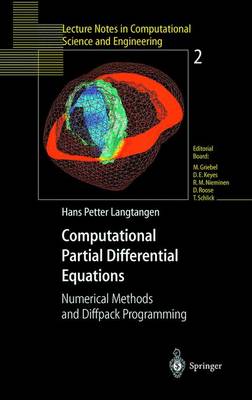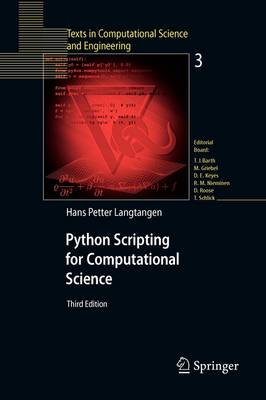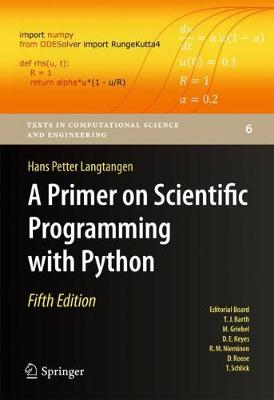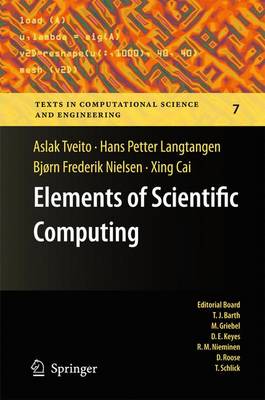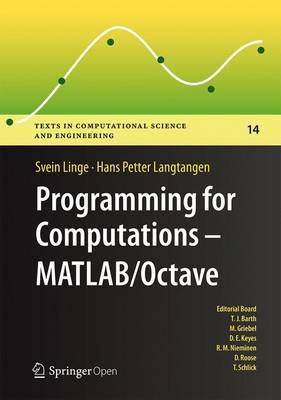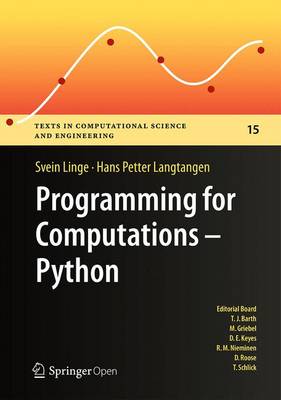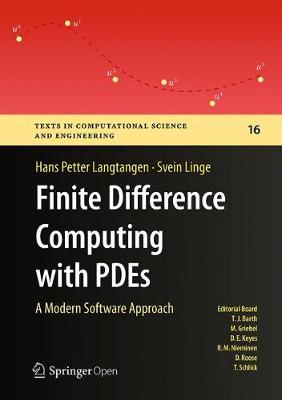Texts in Computational Science and Engineering
8 primary works
Book 1
Book 3
With a primary focus on examples and applications of relevance to computational scientists, this brilliantly useful book shows computational scientists how to develop tailored, flexible, and human-efficient working environments built from small scripts written in the easy-to-learn, high-level Python language. All the tools and examples in this book are open source codes. This third edition features lots of new material. It is also released after a comprehensive reorganization of the text. The author has inserted improved examples and tools and updated information, as well as correcting any errors that crept in to the first imprint.
Book 6
The book serves as a first introduction to computer programming of scientific applications, using the high-level Python language. The exposition is example and problem-oriented, where the applications are taken from mathematics, numerical calculus, statistics, physics, biology and finance. The book teaches "Matlab-style" and procedural programming as well as object-oriented programming. High school mathematics is a required background and it is advantageous to study classical and numerical one-variable calculus in parallel with reading this book. Besides learning how to program computers, the reader will also learn how to solve mathematical problems, arising in various branches of science and engineering, with the aid of numerical methods and programming. By blending programming, mathematics and scientific applications, the book lays a solid foundation for practicing computational science.
From the reviews: Langtangen … does an excellent job of introducing programming as a set of skills in problem solving. He guides the reader into thinking properly about producing program logic and data structures for modeling real-world problems using objects and functions and embracing the object-oriented paradigm. … Summing Up: Highly recommended.
F. H. Wild III, Choice, Vol. 47 (8), April 2010
Those of us who have learned scientific programming in Python ‘on the streets’ could be a little jealous of students who have the opportunity to take a course out of Langtangen’s Primer.”
John D. Cook, The Mathematical Association of America, September 2011
This book goes through Python in particular, and programming in general, via tasks that scientists will likely perform. It contains valuable information for students new to scientific computing and would be the perfect bridge between an introduction to programming and an advanced course on numerical methods or computational science.
Alex Small,IEEE, CiSE Vol. 14 (2), March /April 2012
“This fourth edition is a wonderful, inclusive textbook that covers pretty much everything one needs to know to go from zero to fairly sophisticated scientific programming in Python…”
Joan Horvath, Computing Reviews, March 2015
Book 7
Elements of Scientific Computing
by Aslak Tveito, Hans Petter Langtangen, Bjorn Frederik Nielsen, and Xing Cai
Book 14
Programming for Computations - MATLAB/Octave
by Svein Linge and Hans Petter Langtangen
This book presents computer programming as a key method for solving mathematical problems. There are two versions of the book, one for MATLAB and one for Python. The book was inspired by the Springer book TCSE 6: A Primer on Scientific Programming with Python (by Langtangen), but the style is more accessible and concise, in keeping with the needs of engineering students. The book outlines the shortest possible path from no previous experience with programming to a set of skills that allows the students to write simple programs for solving common mathematical problems with numerical methods in engineering and science courses. The emphasis is on generic algorithms, clean design of programs, use of functions, and automatic tests for verification.
Book 15
Programming for Computations - Python
by Svein Linge and Hans Petter Langtangen
This book presents computer programming as a key method for solving mathematical problems. There are two versions of the book, one for MATLAB and one for Python. The book was inspired by the Springer book TCSE 6: A Primer on Scientific Programming with Python (by Langtangen), but the style is more accessible and concise, in keeping with the needs of engineering students.
The book outlines the shortest possible path from no previous experience with programming to a set of skills that allows the students to write simple programs for solving common mathematical problems with numerical methods in engineering and science courses. The emphasis is on generic algorithms, clean design of programs, use of functions, and automatic tests for verification.
Book 16
Finite Difference Computing with PDEs
by Hans Petter Langtangen and Svein Linge
This book is open access under a CC BY 4.0 license.
This easy-to-read book introduces the basics of solving partial differential equations by means of finite difference methods. Unlike many of the traditional academic works on the topic, this book was written for practitioners. Accordingly, it especially addresses: the construction of finite difference schemes, formulation and implementation of algorithms, verification of implementations, analyses of physical behavior as implied by the numerical solutions, and how to apply the methods and software to solve problems in the fields of physics and biology.
Book 21
Introduction to Numerical Methods for Variational Problems
by Hans Petter Langtangen and Kent-Andre Mardal
This textbook teaches finite element methods from a computational point of view. It focuses on how to develop flexible computer programs with Python, a programming language in which a combination of symbolic and numerical tools is used to achieve an explicit and practical derivation of finite element algorithms. The finite element library FEniCS is used throughout the book, but the content is provided in sufficient detail to ensure that students with less mathematical background or mixed programming-language experience will equally benefit. All program examples are available on the Internet.
